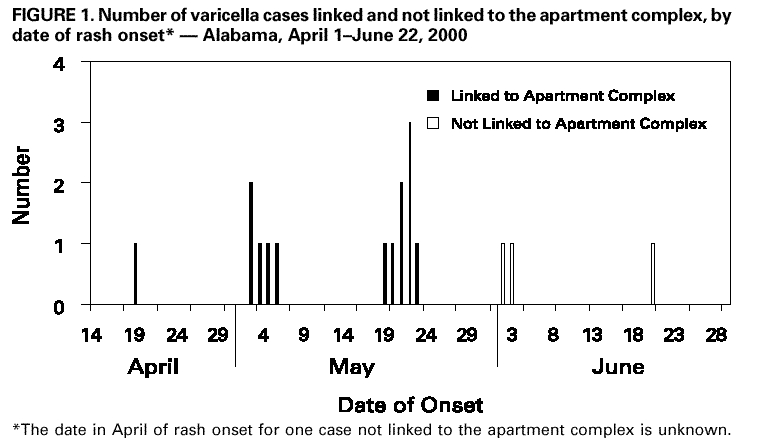 |
|
|
|
|
|
|
| ||||||||||
|
|
|
|
|
|
|
||||
| ||||||||||
|
|
|
|
|
Persons using assistive technology might not be able to fully access information in this file. For assistance, please send e-mail to: mmwrq@cdc.gov. Type 508 Accommodation and the title of the report in the subject line of e-mail. Public Health Dispatch: Varicella Outbreaks Among Mexican Adults --- Alabama, 2000On May 19, 2000, a physician in southern Alabama reported seven cases of varicella to the Alabama Department of Public Health (ADPH). All the cases were in previously healthy young adults living in an apartment complex in town A and working in a poultry processing plant in nearby town B. On May 24, ADPH invited CDC to assist in outbreak investigation and control. This report summarizes the investigation. Investigators identified 18 varicella cases among persons with illness onset during April 1--June 22; 14 patients resided in the same apartment complex (Figure 1). Of the 18 cases, 17 were confirmed* and one was probable. Two patients developed severe complications (pneumonia and ataxia with postviral sensory neuritis) and were hospitalized. All the patients were born in Mexico. The median age was 22 years (range: 18--28 years), and 17 were men. On May 31, ADPH initiated control measures at the apartment complex and poultry processing plant. To increase community awareness, ADPH distributed flyers in English and Spanish and gave press releases to the local news media. In the apartment complex, ADPH vaccinated susceptible persons on the basis of disease history and performed serology to identify those who would need a second dose of vaccine. At the plant, ADPH offered serologic testing to all workers and vaccinated persons with a negative varicella IgG. On June 22, a second cluster of seven varicella cases was identified among adults born in Mexico who worked at a sawmill in another Alabama county. The two outbreaks could not be linked. Varicella outbreaks among adults are less common than among children. Because the potential for serious disease is higher in adults, state and local health departments should be alert to these outbreaks. In addition, the susceptibility among adults from certain regions in Mexico is higher than in U.S.-born adults (2). Outbreaks associated with severe complications or among adults and adolescents should be investigated and controlled (1). During varicella outbreaks, infected patients should be isolated at home; varicella vaccine is recommended for exposed persons (3). Depending on urgency, vaccination can be offered on the basis of a negative or uncertain disease history and/or a negative serologic test. Because most adults with a negative or uncertain varicella history are immune to varicella when tested, serologic testing may decrease the number of vaccine doses needed for outbreak control (4). Virus isolation from vesicular fluid, a swab from the base of a skin lesion, or from saliva can assist in confirming an outbreak. Exposed persons who are at high risk for severe disease, including susceptible pregnant women, should receive varicella zoster immune globulin (VZIG) within 96 hours of varicella exposure (1). Managing varicella in adults includes the routine administration of acyclovir. The optimal strategy for varicella control is to prevent outbreaks by implementing existing policy recommendations. The Advisory Committee on Immunization Practices recommends vaccinating susceptible adults, especially those at high risk for exposure or transmission (3). Reported by: C Woernle, MD, G Higginbotham, R Judy, Alabama Dept of Public Health. E Gordon, DO; National Varicella-zoster Virus Laboratory, Div of Viral and Rickettsial Diseases, National Center for Infectious Diseases; Child Vaccine Preventable Diseases Br, Epidemiology and Surveillance Div, National Immunization Program, CDC. References
* A confirmed case was one that was laboratory-confirmed or that met the clinical case definition and was linked epidemiologically to a confirmed or to a probable case (1). Figure 1  Return to top. Disclaimer All MMWR HTML versions of articles are electronic conversions from ASCII text into HTML. This conversion may have resulted in character translation or format errors in the HTML version. Users should not rely on this HTML document, but are referred to the electronic PDF version and/or the original MMWR paper copy for the official text, figures, and tables. An original paper copy of this issue can be obtained from the Superintendent of Documents, U.S. Government Printing Office (GPO), Washington, DC 20402-9371; telephone: (202) 512-1800. Contact GPO for current prices. **Questions or messages regarding errors in formatting should be addressed to mmwrq@cdc.gov.Page converted: 8/17/2000 |
|||||||||
This page last reviewed 5/2/01
|